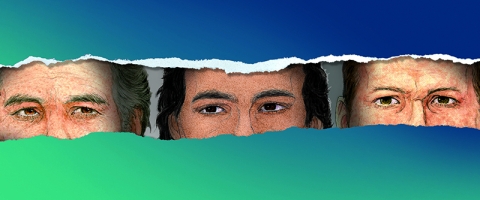
Experts in ancient DNA at the University of Portsmouth have helped shed new light on the surprisingly diverse ethnic make-up of Britain hundreds of years ago.
Dr Sam Robson and Dr Garry Scarlett worked with the Mary Rose Trust to identify the backgrounds of some of those who lost their lives when the royal flagship sunk in the Solent in 1545.
After a painstakingly detailed analysis of DNA from one of the ship’s men (who the Mary Rose Trust named Henry), the results suggest that despite the fact that he likely grew up in Western Britain, his ancestors may have come from North Africa or the Near East.
The research was filmed for a documentary that aired on Skeletons of the Mary Rose: The New Evidence, part of the award-winning series Secret Histories, on Channel 4 last night (March 17).
The Portsmouth team, funded by the Pilgrim Trust, performed exhaustive genetic analyses of two different types of DNA; nuclear DNA (which is the genetic blueprint for each unique individual), and mitochondrial DNA (which is more abundant and passed down almost exclusively from our mothers).
Dr Robson, senior research fellow and lead bioinformatician on the project, said, “We didn’t have a lot of DNA to go on, and ancient DNA is highly likely to be contaminated or to have become severely damaged, but even so our results are compelling. Both the nuclear and the mitochondrial DNA consistently suggest that he hailed from North Africa or the Near East.”
Only a handful of the ship’s 500 crew survived when she sank. Remains of about a third of the crew have been found, with the rest lost to the sea.
It is believed Henry was aged under 20. His was one of the most complete skeletons found and was with three others in a small area in the hold surrounded by barrels and caulking tools.
“It has been an incredibly interesting story to be a part of, and we have learned a huge amount along the way”, said Dr Robson. “Being able to take a snapshot of the past and uncover previously unknown information about the background of these characters from centuries ago has been very insightful."
We didn’t have a lot of DNA to go on, and ancient DNA is highly likely to be contaminated or to have become severely damaged, but even so our results are compelling.
Dr Sam Robson, Senior Research Fellow in Bioinformatics
The research, which also involved Swansea University and the University of Cardiff, forms the basis of a new exhibition at the Mary Rose Museum. The Many Faces of Tudor England is open from today until the end of 2019.
In 2014, Dr Scarlett used ancient DNA analysis to identify the breed of the ship’s dog as similar to a modern Jack Russell.
He said: “It’s interesting to think the crew of the Mary Rose may have been more diverse than generally thought.”
The team are continuing to refine their techniques in order to explore the entire Mary Rose collection, to gain an understanding of our recent genetic past.
“Understanding how the genetics of, for instance, disease risk has changed in the recent past can help us to understand how our DNA can be linked to inherent risks in the present day,” Dr Robson said.
